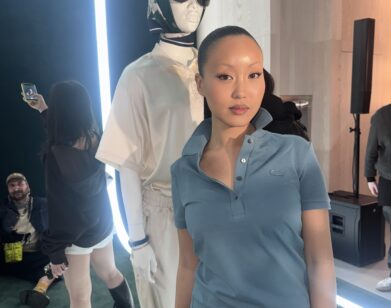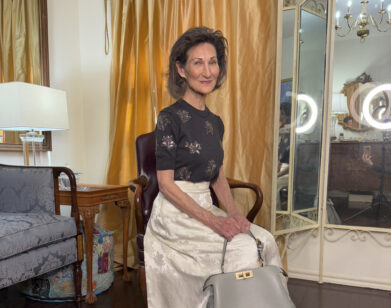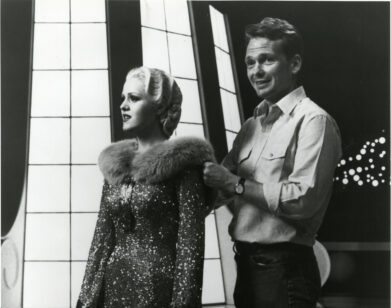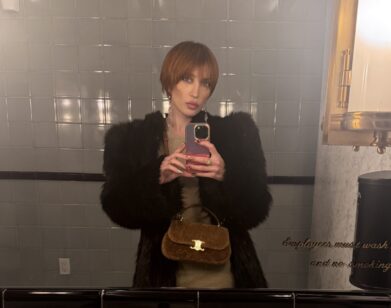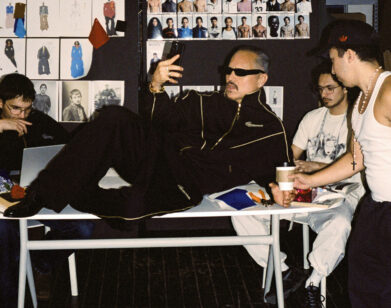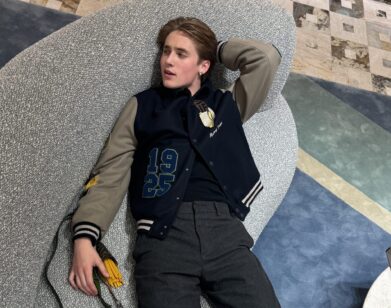ARMOR
“It’s Wilder in the Dark”: Tish Weinstock and Amanda Harlech on What It Takes to Be Goth

Ahead of the U.S. release of How to Be a Goth: Notes on Undead Style, the British Vogue editor, writer, and it girl Tish Weinstock calls up fellow fashion icon Amanda Harlech—the inimitable stylist and consultant to legends like John Galliano and Karl Lagerfeld, to discuss black clothes, covens, and embracing the darkness, one look at a time.
———
AMANDA HARLECH: Hi. I can’t see you.
TISH WEINSTOCK: Do we want video? I’m in bed.
HARLECH: Lucky you. Oh, hi.
WEINSTOCK: Hi. How and where are you?
HARLECH: I’m in the flat in London. I was on day two of a hurly burly day.
WEINSTOCK: Oh, gosh.
HARLECH: You know, osteo, acupuncture, all of that. This armor has to be set in place, ready for the world.
WEINSTOCK: Fashion week! I was trying to think when we first met, it might have been backstage.
HARLECH: It was. Obviously I knew of you and had been sort of watching from afar. I was like, “Here’s somebody I want to dress like, Tish in a little wisp of Galliano gossamer on the steps outside.” I remember you turning to me and saying, “But you’re not wearing black.” I remember making a sort of helpless face. “Yeah, I’m working for Fendi, so I’m wearing a Kim Jones Fendi coat, which is not black.” [Laughs]
WEINSTOCK: No, but you still embody that spirit. And on the subject of black, thank you for writing your exquisite piece on black. I made it the preface because it was so great.
HARLECH: I was so honored. Thank you.
WEINSTOCK: When I read it, I was like, “I don’t really need to ask anyone else to do anything because it explains it all.” But I wanted to ask if you could elaborate a little bit on the magic of black and just your thoughts on the color—well it’s not a color, the shade.
HARLECH: But it’s every color. Black eats everything.
WEINSTOCK: I love it. Go on.
HARLECH: And blackness actually meant burn bright, so black is actually is white as well. And interestingly, I always think of black and white film, if you are shooting red, that red appears black, which is also potent.
WEINSTOCK: It’s like Lucifer, the devil, which we associate with darkness. Lucifer lacks light. I think light and dark are part of the same thing. You can’t have one without the other.
HARLECH: And the shadow is the thing that defines.
WEINSTOCK: Totally. At what point were you first drawn to a sort of darker aesthetic?
HARLECH: Well, I had a dressing up box and in that dressing up box was a Christian Dior cocktail dress with layers of mousseline with a sort of bodice and—
WEINSTOCK: Where’s that now?
HARLECH: I really wish I knew. But in order to make my witch’s outfit for Halloween, I decided to cut little jagged holes in the dress with some nail scissors.
WEINSTOCK: Perfect.
HARLECH: Mum being mum, she threw everything out. But I loved wearing it. When you suddenly find the freedom of wearing black without the distraction of a pattern or a color—it always felt to me as honorable and pure. And I was sent to Marlborough [a boarding school in the UK], in the early days them accepting girls, girls so it was 999 boys, 100 girls—
WEINSTOCK: Wow.
HARLECH: And the girls would walk in to lunch and we were marked out of 10 as we walked by the senior guys.
WEINSTOCK: Oh, I had that at Westminster. It was the pits.
HARLECH: I couldn’t get this boarding school thing down at all, and my parents were simultaneously divorcing and moving out of London. You didn’t have a uniform as a Sixth Form girl, so I had these black high boots, probably from Ravel or something like that, and black coats. I got the name, The Whipper.
WEINSTOCK: Okay, love
HARLECH: And then by the time I got to Oxford, it quickly was ditched for boy black bondage trousers and a huge black sweater. Wearing something oversized is not to make you a big thing in a room. I think it makes you actually appear more fragile.
WEINSTOCK: I completely agree, because you’re sort of swaddled and you shrink into it weirdly.
HARLECH: Yeah. Dressing, in part, is to be loved or to be accepted, even though you don’t want to be accepted by most people. But at that point I wanted to be loved, so that stayed. And then bang, suddenly I’m in London and got a job at Harpers & Queen. I remember wearing black leather trousers with a black crew neck sweater, and I had very short hair. That new romantic thing then morphed into the artful dodger, plus top hat, plus long black wig with fake ivy that I then wrapped in a coronet around my head and wore with vintage dresses. There was a theatrical thing called Charles Fox makeup. It was a water-based pot of pure white. I’d put it all over my face and then draw on black panda eyes. I remember meeting Leslie Kenton, who was this very extraordinary beauty writer back then in the early eighties. And I remember her saying as I went in with a frock coat, black waistcoat, black leggings, and my black jazz shoes, “Don’t you find all of that really complicated? Doesn’t that cut across your consciousness to be in so many layers?”
WEINSTOCK: I need to see some pictures one day. It’s funny because I was definitely aware of you and your crew, Daphne [Guinness] and—
HARLECH: Lucy [Birley].
WEINSTOCK: Lucy, exactly. I think all of you seem to sort of defy what it means to be a sort of traditional woman. What was interesting is none of you looked very polite or cheery. It was feminine, but in a really kind of empowered and strong way. And a lot of that was to do with this element of darkness. Were you aware of that at the time, that you all belonged to this coven of witches?
HARLECH: I didn’t necessarily link us all together into a team, but we were all reacting to the eighties; the big shoulders, the bling, and the loudness. I think we all identified with a broken heart, so our dressing reflected that. Lucy did the subversive thing. One minute she could be in a puffball dress, but she’d always offset it with a bowler hat or a mad pair of Manolos. Daphne was trailing Lee McQueen and dragging ripped beautiful embroidered shawls through the mud. I think there’s something beautiful in carelessness when it’s done with real poetry. And it wasn’t about brand or money and stuff like that, which came later.
WEINSTOCK: But that idea of a broken heart is really interesting because we’re all taught by society told to not show sadness or darkness, but I think it’s important to get in touch with that, which is basically what I wanted the book to be about—women who are a little bit sad and are a little bit dark and are a little bit strange—because I don’t think that that’s really encouraged at all. Had you always been in touch with that darkness, or is it something that you felt safer in later years to explore?
HARLECH: Working with John [Galliano]—actually, I don’t think it was black that I wore. I had two little children so it was a very happy time because my heart was full of love for them. But by the time I was at Chanel, I was in black. I did not want to draw attention to myself in the studio. But curiously, like Gabrielle Chanel says, in a little black dress you walk into the room and everybody notices you because you are the shadow that defines. You are not all tricked up in sort of color or frothy white or flowers and masses of jewelry. It just wasn’t about that. I just wanted to be lean. I wanted to be a little bit mean. I wanted to be graceful as a cat. And with the economy of a cat, I wanted to be able to leap out of a situation when it got difficult.
WEINSTOCK: I mean, black really can protect you. It’s like armor. Who would you say are your gothic heroines?
HARLECH: Well, me in the 17th century when I definitely was alive. The idea of a witch has definitely been something that has always drawn me. Tallulah and I burn the collection of dried flowers and ears of wheat that sits on the top of the temple in the hall at home on New Year’s Eve and sort of let go of everything negative, that’s actually some witchcraft.
WEINSTOCK: I think it’s really grown. So many more people are bringing witchcraft and the spiritual world into their lives.
HARLECH: Because the witch was actually often an older woman who’d lost her husband or something, she would withdraw into the forest and children would see her as this old hag with hairs growing out of her moles. But actually she was, I would say, a post-menopausal woman who was very spiritual, who was taught about nature and invoking the things that really matter.
WEINSTOCK: I completely agree. That’s another reason why I wanted to write the book now, because, culturally, we are starting to embrace that much more in the mainstream—the idea of the witch and all things spooky. We had the Tim Burton exhibition at the Design Museum. He did Beetlejuice. There was Wednesday Addams, and there’s also Nosferatu.
HARLECH: Nosferatu, I don’t dare go and see.
WEINSTOCK: Well, I will say Lily-Rose Depp is brilliant. I was surprised how good she was. In music, there’s Ethel Cain embracing the darker side. And of course, John’s amazing Margiela collection.
HARLECH: That show.
WEINSTOCK: Stunning. But there’s definitely this embrace of darker culture. I wanted to get your thoughts on why you think now, especially, we’re leaning towards the shadows.
HARLECH: Well, have you read Orbital?
WEINSTOCK: No.
HARLECH: Okay. Samantha Harvey, her writing is so brilliant. It’s about six astronauts who are rotating around the planet at high speed. And they see the beauty of this fragile earth. I think when we go to the darkness it’s actually about seeking the wild where there is a truth, the heart of Gaia and nature. It’s really important to tap into that.
WEINSTOCK: Also the world is going to shit at the moment.
HARLECH: The whole passage of what they see happening to the earth from the rocket, the degree of pollution, they’re looking down from space on this precious shimmering earth that is fated with all sorts of fires and floods and typhoons. There is no reason for boundaries and wars—or politics, actually. But I think there’s this feeling that we need to tap into the wild. It’s wilder in the dark, isn’t it?
WEINSTOCK: Totally. But there’s also this sort of calm and peace, even though it is wild and unknown. I think when you embrace the darkness, there is a kind of solace, actually.
HARLECH: I think it’s really important to embrace and accept the fact that you are alone and you are very small and very meaningless. From that point, you can grow.
WEINSTOCK: Well, we are the center of our own universes, but I think you need to have that sense of perspective. What does goth mean to you?
HARLECH: You do think of Bram Stoker and that sort of Victorian gothic revival. In a way, the whole goth thing is a yearning to go into the wild, backwards into the past. Where I draw the line is the Doc Martens.
WEINSTOCK: Why?
HARLECH: I like pointy toes because for me, so much of beauty is defined by grace, which is movement. And I don’t think the thumpers are good for that.
WEINSTOCK: You don’t like clodhoppers?
HARLECH: No. But it’s more a question of what makes you feel good in the way you move. I can’t walk in my seven-inch heels anymore. I mean I can, but I don’t want to wreck my ankle again. So we’ve gone lower, but I still look at them. I’ve got every single shoe in a cupboard in my boudoir, which is a dressing room, and it’s like the most beautiful—
WEINSTOCK: Do you think you should be comfortable?
HARLECH: This is where I’d have an argument with Izzy [Isabella Blow].
WEINSTOCK: Go on.
HARLECH: Because Izzy would say, “Amanda, you are turning into a boiled egg in the countryside because you’re not wearing your Manolos. You’re wearing jeans,” in a sort of horror.
WEINSTOCK: Was that her worst nightmare?
AMANDA HARLECH: Yes. When she came to stay at Glyn [Gyn Cywatch, home of the Harlech family], she walked up to the folly in Manolos. [Laughs] And I kid you not, it’s a perilous high climb up and down. But, I’m not 30 anymore. I’m not going to make that excuse because there are plenty of extraordinary 60-year-olds like Annette de la Renta who are flawless and never drop their standards, but I don’t like to be conscious of something hurting my foot or being too tight if I’m working. It’s a very different thing going to something and your role is to bear witness. But if I’ve got to work with my hands, I need to free myself from my body because I don’t need people looking at me.
WEINSTOCK: Well, it sounds like your approach to style has changed with age—
HARLECH: No. I don’t think I wore heels when I was styling for John. I do it for the photograph, but I’ve never been one of the real troopers like you. Actually, you wear your ballet flats a lot of the time.
WEINSTOCK: Well, I’m a bit like Bambi on ice. It’s not about comfort. It’s just that I’m so mal-coordinated that a foot might go one way and I go the other. Especially if I’m holding a glass of champagne, it’s a nightmare.
HARLECH: Exactly. Don’t want that. Lucy and Izzy, they never ever wore anything less than perfection. They all wore heels.
WEINSTOCK: And I’m so used to seeing Daphne in those shoes that when she’s not wearing them, it really freaks me out. I’m used to her existing at a certain height.
HARLECH: But Daphne is like a Spartan in what she—I won’t say sacrifices herself for, but her art—she has given herself to that. I think I’m too selfish.
WEINSTOCK: What do you mean?
HARLECH: I’m not going to sacrifice myself because I’ve got other things to do. I want to find the mountains at Glyn and I want to swim in the lakes and I want to ride a horse. I don’t necessarily only want to walk on stilts. But I’m also not a musician.
WEINSTOCK: Yeah. It’s very different. She’s true to her and you’re true to you. I tell you what, I absolutely loved that shoe when you guys swapped identities.
HARLECH: I know. That was Stephen Gan’s idea for V Magazine, and Karl [Lagerfield] really got off on it.
WEINSTOCK: It was amazing. I was looking at them earlier.
HARLECH: What that did do was identify each of our styles.
WEINSTOCK: Did it feel weird being someone else?
HARLECH: It felt weird looking at myself. That was really freaky because there’s Daphne wearing my dress with hair looking like how mine usually is with my kind of makeup. That was really freaky, Karl couldn’t believe it. He couldn’t stop taking pictures because it was so out of body.
WEINSTOCK: Gosh, I feel like there’s not enough of that. You don’t really get characters anymore.
HARLECH: Well, there was no iPhone back then.
WEINSTOCK: That’s very true.
HARLECH: Every celebrity, they’ve got their minders who make sure that their image is absolutely incorruptible. Helena Bonham Carter had a degree of freedom, but even she was treated with a sort of question mark.
WEINSTOCK: She’s a style icon, but I remember the press would be like, “Bag lady.”
HARLECH: No!
WEINSTOCK: She was major, still is. But yeah, you don’t really see that anymore. Everything’s very manufactured, even if it’s meant to be a bit off-kilter. What advice would you give to younger girls who feel like a bit of an outsider and want some guidance expressing themselves?
HARLECH: Dress as you like. It’s all about freedom of speech. Identify with an exile who refuses to conform. And I think in that bid for freedom, don’t be afraid to wear black, because it’s an absolute liberty from the whole patterned kaleidoscope of what’s out there. It’s like freeing yourself to a single thing that’s as clear as a full stop, and you can be forever you.
WEINSTOCK: Perfect. Well, thank you so much. It was great chatting. So much love to you.
HARLECH: Thank you. Love you.
WEINSTOCK: Bye bye.

